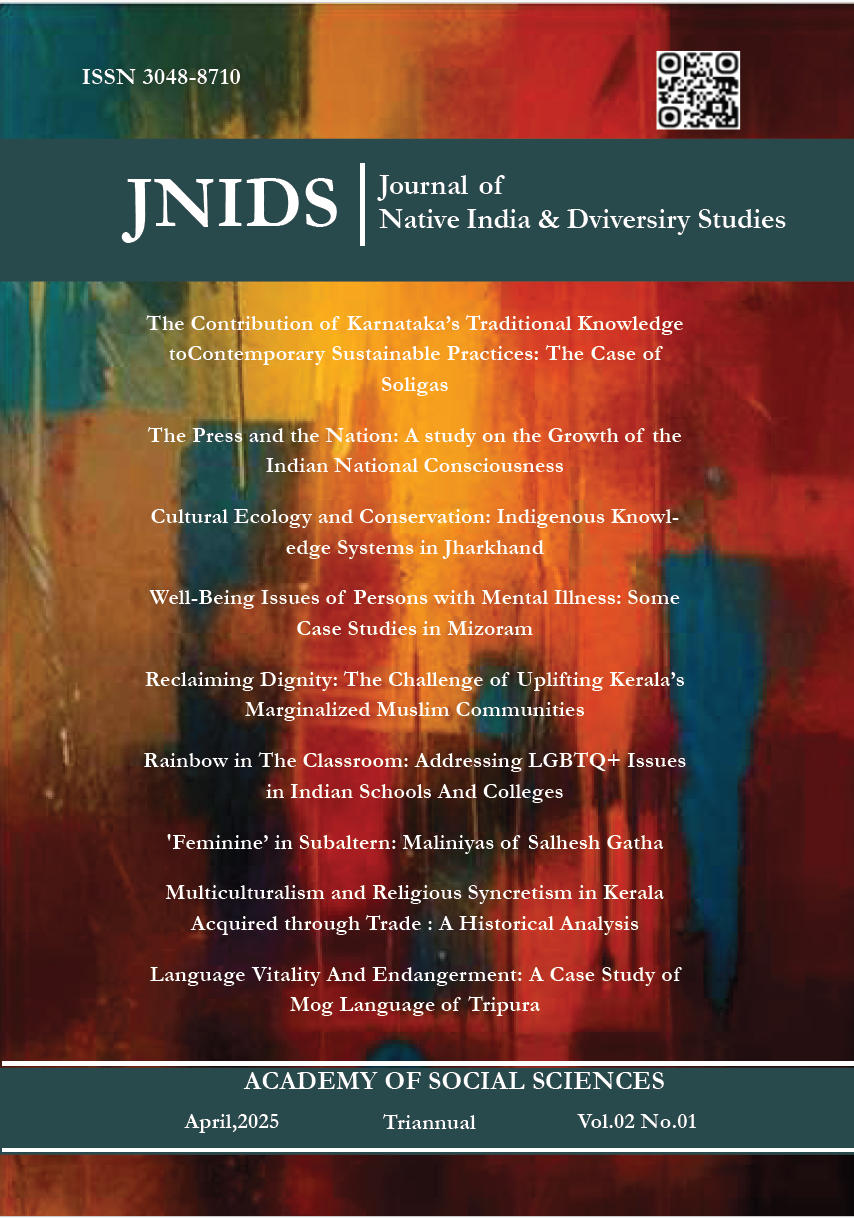‘Feminine’ in Subaltern: Maliniyas of Salhesh Gatha
DOI:
https://doi.org/10.62656/Keywords:
Malins, Salhesh, Feminine, Mithila, CultureAbstract
Folk narratives are cultural repositories of societal values and meanings. This paper examines the changing meanings of feminine and femineity for the subalterns in Mithila region of Bihar. It is based on a study of three texts with Raja Salhesh as the central character. These texts mark critical junctures in the history of the region in relation to the nation and its political vibrations. The paper attempts to analyse these disparate texts as reflective of the transformations in female agency and sexuality in cultural discourse centred around dalits. The questions of representation of the ‘other’- the ‘colonial lens’, ‘caste-glance’ as well as the ‘male-gaze’ are important intersectional pivots of analysis.
References
1. Alone, YS (2022). Shiva: Not a God of subaltern communities, Outlook, October 28.
2. Amin, Shahid (1995), Event, Metaphor and Memory: Chauri Chaura 1922-1992, Oxford University Press: Delhi.
3. Beremann, Gerald D (1993). Sanskritisation as Female Oppression, in Miller, Barbara D (ed) Sex and Gender Heirarchies, Cambridge University Press.
4. Brass, Paul R. (1974). Language Religion and Politics in North India, Cambridge University Press: London.
5. Chakravarty, Uma (1993), ‘Conceptualising Brahmanical Patriarchy in Early India: Gender, Caste, Class and State, EPW, Vol 8: 14, pp. 579-585
6. Chowdhary, Prasann Kumar and Srikant (2001), Bihar mein samajik parivartan ke kuch aayam, Vaani Prakashan, Delhi. p.60-83.
7. Collins, Patricia Hill (1990). Black Feminist Thought: Knowledge, Consciousness and the Politics of Empowerment, Unwin Hyman: Boston.
8. Devi, Yashoda (1960). Dusadh Jati Ek Samiksha, Kanak Press: Patna.
9. Grierson, GA (1880). An Introduction to the Maithili Language of North Bihar containing a Grammar, Chrestomathy and Vocabulary- Part I, Extra number to Journal Asiatic Society of Bengal, JN Banerjee and Son: Calcutta.
10. Grierson, GA (1926). Bihar Peasant Life: Being Discursive Catalogue, 2nd edition, Government Printing, Bihar and Orissa: Patna.
11. Gupta, Charu (2001). Sexuality, Obscenity, Community: Women, Muslims and the Hindu Public in Colonial India, Permanent Black: Ranikhet.
12. Hanks, W. F. (1989). Text and Textuality. Annual Review of Anthropology, 18, 95–127. http://www.jstor.org/stable/2155887
13. movement, OUP: Delhi.
14. Jha, Hetukar(1974). Understanding Caste through its sources of Identity: An account of Shotriyas of Mithila, Sociological Bulletin, Volume 23, Issue 1. p.93-98.
15. Jha, Mithilesh Kumar (2018). Language Politics and Public Sphere in North India: Making of the Maithili
16. Jha, Sachida Nand (2018). Nationalist with a novel idea, Daily Pioneer, 2nd November.
17. Manipadma, (1973). Raja Salhesh, Eitihashik Upanyas, Maithili Prakashan Samiti: Calcutta.
18. Mishra, Jaykant (1950). The Folk Literature of Mithila, Allahabad. Quoted in Maun, Prafull Singh and Ram Pratap Neeraj (ed.) (2002), Raja Salhesh, Namita Prakashan, Muzzaffarpur.
19. Narayan, Badri (2001), Documenting Dissent, Indian Institute of Advanced Studies: Shimla.
20. Narayan, Badri (2009). Fascinating Hindutva, Sage Publication: Delhi.
21. Neeraj, Rampratap (2002), Etihasik purush: Raja Salhesh, in Raja Salhesh, Maun, PK and Ram Pratap Neeraj (ed.), Namita Prakashan, Muzzaffarpur.
22. Phelps, Ethel Johnston (1981), The Maid of the North: Feminist Folk Tales From Around the World, Holt, Reinhart and Winstein: New York.
23. Ram, Mahendra and Phulo Paswan (2007). Salhesh Lokgatha, Sahitya Akademi: Delhi.
24. Rege, Sharmila (1998), ‘A Dalit feminist Standpoint’, Seminar ‘Dalit’; 471, November 1998, pp. 47-52.
25. Thomas, F W Thomas and R L Turner, Proceedings of the British Academy, p. 283-306.

